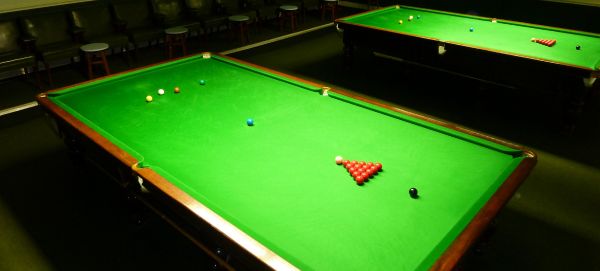
International or “English” snooker is the most widely played form of snooker around the world. It is generally played on 6’x12′ English billiard tables, with cushions that are more narrow than on pocket billiard tables and which curve smoothly into the pocket openings. 5 x 10 and snooker tables of even smaller playing dimensions may be used for the game. On a 6 x 12 snooker (English billiard) table the playing area within the cushion faces shall measure 11′ 8.5″ x 5′ 10″ with a tolerance on both dimensions of +/-0.5″. The height of the table is measured from the floor to the top of the cushion rail, and the height shall measure 34″ with an allowable variance of +/-0.5″.
Balls Used: Set of Snooker balls: fifteen object balls that are not numbered and are solid red (called reds), six object balls of other colors that are not numbered (called colors) and a cue ball (called the white ball). Point values for object balls: red-1, yellow-2, green-3, brown-4, blue-5, pink-6, black-7. In International Snooker the balls used are 2-1/16″ diameter.
The Rack: Play begins with the balls placed as in the diagram above. The pink is spotted on the Pyramid Spot. The apex ball of the triangle of reds is racked as close as possible to the pink without touching it.
Baulk-line and Baulk: A straight line drawn 29″ from the face of the bottom cushion and parallel to it is called the Baulk-line and the intervening space termed the Baulk.
The Half Circle: The Half Circle is a semi-circle described in Baulk with its center at the middle of the Baulk-line and with a radius of 11.5″. When the striker has cue ball in hand within the Half Circle he may place the base of the cue ball anywhere on the line or within the Half Circle, and may use his hand or any part of his cue (including the tip) to position the cue ball–as long as it is judged he is not attempting to play a stroke.
The object of the Game: To score a greater number of points than the opponent.
Scoring: Points are scored in two ways: players are awarded points for fouls by the opponent (see Penalties For Fouls below), and by legally potting reds or colors. Each legally potted red ball has a point value of one; each legally potted color ball has a point value as indicated (Balls Used above). A frame ends when all balls have been potted, following the Rules of Play; If, however, only the black (7) ball is left on the table, the frame ends with the first score or foul. If the players’ scores are equal after that scoring, the black is spotted on its original position and the layers lag or draw lots for the choice of playing at, or assigning opponent to play at, the black ball with the cue ball in hand within the Half Circle, first score or foul then ends the frame.
Opening Break: Players lag or draw lots for choice of a break in the opening frame. In a match format, the players alternate the break in subsequent frames. Starting player has cue ball in hand within the Half Circle. He must cause the cue ball to contact a red ball. It is not necessary to send a ball to a rail or into a pocket. Failure to meet this requirement is a foul (see Penalties For Fouls) A foul is scored and–with all fouls–the incoming player has a choice of (1) accepting the table and becoming the striker, or (2) requiring the offender to break again.
Continue Reading for The Rules of Play, Fouls and so much more.
